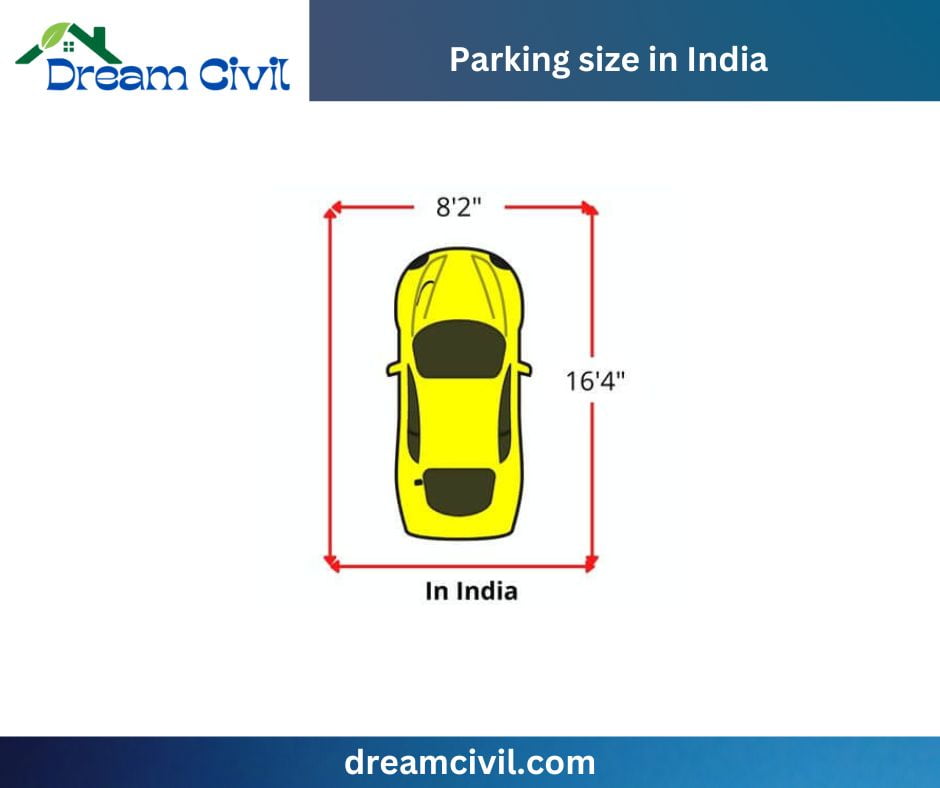Table of Contents
✔ When a vehicle is left unattended in a stationary position for a certain period, it is commonly known as parking.
✔ Generally, parking on either side of a street is acceptable, but some limitations may exist.
✔ For the convenience of those who use a building, parking facilities are frequently supplied, and local and national authorities set guidelines concerning the layout of parking spaces in buildings and on roads.
✔ Parking spaces can be both free or paid, depending upon location. In a parking space, vehicles can be parked in various manners, such as perpendicular, angle, and parallel parking.
1. Parking Space Dimension

| Country/Region | Minimum Width (feet/meters) | Length Range (feet/meters) | Notes |
|---|---|---|---|
| United States | 8.5-9.0 feet (2.6-2.7 m) | 10-24 feet (3.0-7.3 m) | Width may vary based on angle or parallel parking |
| United Kingdom | 7.9 feet (2.4 m) | 16 feet (4.8 m) | Concerns about the size of modern cars |
| Australia | 7.9 feet (2.4 m) | 18 feet (5.4 m) | AS2890 standard |
| France | 7.2-7.5 feet (2.20-2.30 m) | Varies | Norme NF P 91-100 standard |
| India | 7.9-8.2 feet (2.4-2.5 m) | 16-20 feet (4.9-6.1 m) | Varies by local regulations |
| Philipines | 7.9-8.2 feet (2.4-2.5 m) | 16-20 feet (4.9-6.1 m) | Varies by local regulations |
2. Importance of Parking
✔ Having sufficient parking spaces is crucial for the safety of vehicles and to guarantee effective traffic control in urban areas.
✔ Cities must offer satisfactory parking areas for locals and guests to park their cars. Inadequate parking spaces and high prices can deter people from returning to the city for work, dining, shopping, or other activities.
✔ Therefore, cities must take necessary measures to ensure parking is easily accessible and affordable.
✔ Additionally, there must be sufficient parking areas for residents near their homes and areas of employment.
3. Types of Parking
✔ There are three famous parking arrangements: parallel, angle, and perpendicular.

4. Parking Lot Dimension
✔ When selecting a parking spot, it is crucial to consider your vehicle’s size.
✔ Recent studies indicate that since 1999, about 85% of cars on the road have a width of roughly 6 feet 7 inches and a length of 17 to 18 feet.
✔ Parking providers should also consider the appropriate usage of excess parking space. For instance, a busy retail center would require more significant clearance than a less busy one.
✔ Moreover, locations that cater to older users, such as hospitals, should have larger parking space dimensions.
✔ Travelers must have easy access to and exit from the parking area and adequate room to open their car doors.
✔ In low-traffic areas, the door opening space should be 23 inches, while in high-traffic facilities, it should be 27 inches. The recommended parking spot widths based on traffic are presented in the table below.:
| Type of Facility | Width | Length |
|---|---|---|
| Low Traffic ( Students, Employees, etc.) | 8 feet 6 inches | 20 feet |
| Moderate to high Traffic ( Medical Facilities, Retail, etc.) | 9 feet | 20 feet |
5. Parking Space Dimensions In the United States
✔ In the US, parking spaces generally range from 8.5 to 9 feet wide and 18 to 24 feet long.
✔ Thus, a single-car parking space must be at least 8 feet 6 inches wide and 18 feet long.

6. Parking Space Dimensions In the United Kingdom
✔ In the United Kingdom, car parking spaces must have a width of at least 2.4 meters and a length of at least 4.8 meters, per car specifications.
✔ The distance between bays for maneuvering must be 6 meters.
✔ Therefore, the smallest permissible car parking size in the UK should have a width of 7 feet and 10 inches and a length of 15 feet and 9 inches.

7. Parking Space Dimensions In India
✔ According to CMDA policies, a parking area must be at least 2.5 meters (8 feet 2 inches) wide and 5 meters (16 feet 4 inches) long.

Read Also: Vena Contracta
| Verified Article By Er. Madhu Krishna Poudel |

